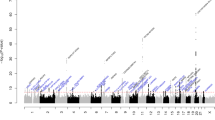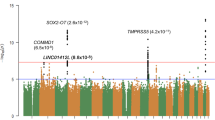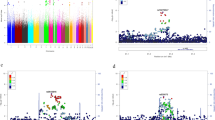Abstract
Cataracts are the commonest cause of blindness worldwide. Inherited cataract is a clinically and genetically heterogeneous disease that most often shows autosomal dominant inheritance. In this study, we report the identification of a novel locus for cerulean cataract type 5 (CCA5), also known as blue-dot cataract on chromosome 12q24. To date, four loci for autosomal dominant congenital cerulean cataract have been mapped on chromosomes, 17q24, 22q11.2–12.2, 2q33–35 and 16q23.1. To map this locus we performed genetic linkage analysis using microsatellite markers in a five-generation English family. After the exclusion of all known loci and several candidate genes we obtained significantly positive LOD score (Z) for marker D12S1611 (Zmax=3.60; at θ=0). Haplotype data indicated that CCA5 locus lies within a region of 14.3 Mb interval between the markers D12S1718 and D12S1723. Our data are strongly suggestive of a new locus for CCA5 on chromosome 12.
Similar content being viewed by others
Log in or create a free account to read this content
Gain free access to this article, as well as selected content from this journal and more on nature.com
or
References
Krumpaszky HG, Klauss V : Epidemiology of blindness and eye disease. Ophthalmologica 1996; 210: 1–84.
Ionides A, Francis P, Berry V et al: Clinical and genetic heterogeneity in autosomal dominant congenital cataract. Br J Ophthalmol 1999; 83: 802–808.
Francis PJ, Berry V, Bhattacharya SS, Moore AT : The genetics of childhood cataract. J Med Genet 2000a; 37: 481–488.
Graw J : The genetic and molecular basis of congenital eye defects. Nat Rev Genet 2003; 4: 876–888. Review.
Shiels A, Bennett TM, Hejtmancik JF : Cat-Map: putting cataract on the map. Mol Vis 2010; 16: 2007–2015.
Vogt A : Lens and Zonule. Bonn: JP Weyenborgh, 1979.
Armitage MM, Kivlin JD, Ferell R : A progressive early onset cataract gene maps to human chromosome 17q24. Nature Genet 1995; 9: 37–40.
Litt M, Carrero-Valenzuela R, LaMorticella DM et al: Autosomal dominant cerulean cataract is associated with a chain termination mutation in the human beta-crystallin gene CRYBB2. Hum Mol Genet 1997; 6: 665–668.
Wang L, Lin H, Gu J, Su H, Huang S, Qi Y : Autosomal-dominant cerulean cataract in a Chinese family associated with gene conversion mutation in beta-B2-crystallin. Ophthalmic Res 2009; 41: 148–153.
Rogaev EI, Rogaeva EA, Korovaitseva GI et al: Linkage of polymorphic congenital cataract to the gamma-crystallin gene locus on human chromosome 2q33–35. Hum Mol Genet 1996; 5: 699–703.
Khan AO, Aldahmesh MA, Ghadhfan FE, Mesfer SA, Alkuraya FS : Founder heterozygous P23T CRYGD mutation associated with cerulean (and coralliform) cataract in 2 Saudi families. Mol Vis 2009; 15: 1407–1411.
Vanita V, Singh D, Robinson PN, Sperling K, Singh JR : A novel mutation in the DNA-binding domain of MAF at 16q23.1 associated with autosomal dominant ‘cerulean cataract’ in an Indian family. Am J Med Genet A 2006; 140: 558–566.
Jamieson RV, Farrar N, Stewart K et al: Characterization of a familial t(16;22) balanced translocation associated with congenital cataract leads to identification of a novel gene, TMEM114, expressed in the lens and disrupted by the translocation. Hum Mutat 2007; 28: 968–977.
Acknowledgements
We would like to acknowledge funding from the Wellcome Trust project Grant 063969/Z/01, EU project ‘PYTHIA’ (FP7-ICT2-224030), and NIHR (Moorfields Eye Hospital Biomedical Research Centre). We would like to thank the members of the family for taking part in this study.
Author information
Authors and Affiliations
Corresponding author
Ethics declarations
Competing interests
The authors declare no conflict of interest.
Rights and permissions
About this article
Cite this article
Berry, V., Ionides, A., Moore, A. et al. A novel locus for autosomal dominant congenital cerulean cataract maps to chromosome 12q. Eur J Hum Genet 19, 1289–1291 (2011). https://doi.org/10.1038/ejhg.2011.130
Received:
Revised:
Accepted:
Published:
Issue date:
DOI: https://doi.org/10.1038/ejhg.2011.130



